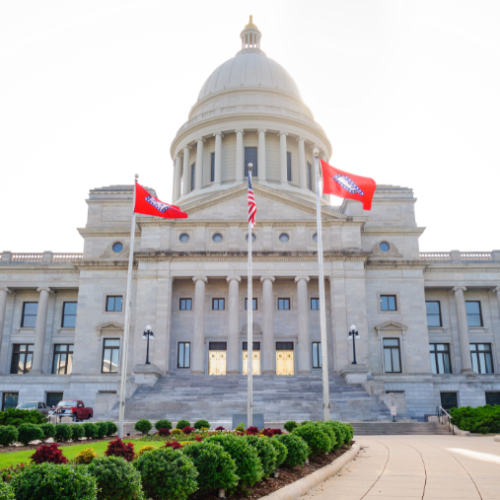Vermont: Monitoring Data Trends after 2020 Justice Reinvestment Initiative Reforms
In 2019, Vermont sought technical assistance under the Justice Reinvestment Initiative (JRI) program to evaluate the impact of supervision revocations on the incarcerated population, assess challenges to supporting people in the criminal justice system who have mental health and substance use disorder needs, and identify opportunities for improving data tracking and analysis to support policymaking. Many of the proposed policies that resulted from this effort were included in Act 148, Vermont’s Justice Reinvestment II legislation, and signed into law in July 2020. Additional legislation was passed in 2021. Since then, the sentenced prison population and overall supervised population have declined due to several factors. This brief highlights these and other accomplishments.
Background
In 2019, Governor Phil Scott convened the Justice Reinvestment II Working Group to identify opportunities for improving public safety and reducing recidivism in Vermont. The working group was tasked with evaluating the impact of supervision revocations on the incarcerated population, assessing challenges to supporting people in the criminal justice system who have mental health and substance use disorder needs, and identifying opportunities for improving data tracking and analysis to support policymaking. Vermont’s Justice Reinvestment Initiative (JRI) was funded by the U.S Department of Justice’s Office of Justice Programs, Bureau of Justice Assistance with additional support from The Pew Charitable Trusts.
With assistance from The Council of State Governments (CSG) Justice Center, the Justice Reinvestment II Working Group developed a set of proposed policy reforms to address the issues noted above. Many of these policies were included in Act 148, Vermont’s Justice Reinvestment II legislation, and signed into law in July 2020. Act 148 did the following:
- Established presumptive parole to reduce reliance on the furlough supervision system
- Streamlined the furlough system to increase consistency of community supervision practices
- Incentivized good behavior by increasing earned time from 5 to 7 days per month for people in prison and on furlough
- Required additional data to be collected and reported on the use of the Department of Corrections’ (DOC) graduated sanctions policy
- Directed the Agency of Human Services to determine gaps in identifying and serving people in the criminal justice system who have behavioral health needs
- Required analysis related to demographics and sentencing to help Vermont better identify and reduce racial disparities in the criminal justice system
Act 148 also reconvened the Justice Reinvestment II Working Group to develop additional recommendations for improving community supervision and post-prison treatment and services, which were included in reports submitted to the legislature in 2021 and 2022. As a result of the working group’s recommendations, the legislature passed Act 24 (2021), which adjusted the probation midpoint review process to encourage discharge for people who meet specific compliance criteria. The legislature also passed Act 14 (2021), which created a pilot program to use presentencing assessments to inform supervision condition setting. Additionally, the working group made appropriation recommendations for future reinvestment funding.
Visit our website for additional information.
Impacts of Legislation on Corrections Population Trends
Vermont’s sentenced incarcerated population declined 32 percent from July 2019 to December 2021, largely because of decreased admissions due to systemwide disruptions from COVID-19, including court closures, fewer in-person supervision visits, and changes in policing patterns. This population decline is significantly lower than the decrease initially projected to result from Vermont’s Justice Reinvestment II reforms in 2019. The number of people housed out of state also declined 50 percent since March 2020 due to decreases in the overall incarcerated population. Vermont should continue to utilize JRI reforms to avoid a significant rebound in the state’s incarcerated population and maintain, or potentially even further decrease, spending on out-of-state contract beds. This will allow the state to increase reinvestments in community-based responses while intentionally focusing incarceration resources on people who pose the greatest risk to public safety.
Vermont Sentenced Population: Actual and Projected, FY2016–FY2025¹

Initial projection models did not account for changes in the prison population since the onset of COVID-19 and so should be considered within a very limited context.
From July 2019 to June 2022, Vermont’s community supervision population decreased 33 percent. While the state’s supervised population has been declining since fiscal year (FY)2016, disruptions in court processes due to the onset of COVID-19 accelerated population reductions beginning in March 2020. A reduction in revocations in FY2020 and FY2021 may also have contributed to recent decreases in the community supervision population. However, the impact of COVID-19 cannot be fully differentiated from trends resulting from Justice Reinvestment II policy changes.
Vermont’s Supervised Population: July 2016–June 2025²

The projection here simulates a status quo trajectory of the supervision population. It does not include an impact projection from JRI policies, nor does it factor the COVID-19 pandemic into the numbers.
While all community supervision caseload populations have decreased since March 2021, the number of people on furlough has declined 40 percent. Although this reduction likely reflects COVID-19 system disruptions, it is a promising early indication of Vermont’s decreased reliance on furlough supervision.
Through JRI, Vermont DOC better aligned existing policies and practices with evidence-based approaches in supervision. This included revising supervision contact standards and conditions, as well as developing a new sanction grid and revocation process. These reforms will support ongoing recidivism-reduction efforts critical to helping Vermont achieve its JRI goal of reducing the use of incarceration while maintaining public safety.
Community Supervision Population by Type, March 2021–June 2022³

*Not pictured in the graph are the following supervisions types: Work Crew, Other, and ICOTS (Interstate Compact Offender Tracking system)
Monitoring Racial Disparities in Incarceration
Initial Justice Reinvestment II analysis findings indicated the disproportionate representation of Black people across all corrections populations in Vermont. Specifically, Black people were found to be incarcerated at six times the rate of White people. Through the state’s racial equity in sentencing analysis conducted by the CSG Justice Center, Vermont became the first state to use a JRI approach to better understand the drivers of these disparities through an in-depth analysis of data from the Vermont court system and DOC.
While court data are not available on an ongoing basis through Vermont’s data monitoring and so cannot be included in this report, DOC does provide CSG Justice Center staff with current racial and ethnic breakdowns of the incarcerated and supervised populations. In August 2020, DOC began collecting ethnicity data in a separate database field, allowing the agency to report on trends related to race and ethnicity with greater precision.
Race and Ethnicity of DOC Populations, June 2022 4

While the racial composition of the sentenced incarcerated population has fluctuated somewhat from 2019 to 2022, Black people remain disproportionately represented, and Vermont should continue efforts to implement recommendations from the racial equity in sentencing analysis to address this disparity. The racial composition of the detained population experienced an increase in the proportion of Black people detained during this same period. The state should continue monitoring this trend, including through the examination of additional data to better understand potential drivers of this increase.
Change in Racial Composition of Incarcerated Population,
June 2019, July 2020, July 2021, and July 2022 5

Selected Policy Implementation and Outcome Measures
Implementing Presumptive Parole
Vermont’s new presumptive parole process went into effect on January 1, 2021. As of June 2022, the parole board has considered 16 total presumptive parole cases and scheduled 4 of those for hearings to provide an opportunity for victim input. Two cases were ultimately denied parole after their hearings.
The number of cases referred to the parole board in the first year of implementation is 68 percent fewer than initially projected during the Justice Reinvestment II policy development process. However, the projections were developed prior to the pandemic when the sentenced population was significantly larger. Data available through ongoing DOC system upgrades will provide additional information to better understand the underutilization of this policy, including the number of people who are determined to be ineligible for presumptive parole and why.
Presumptive Parole Decisions by the Vermont Parole Board,
January 2021–June 2022 6

Monitoring Returns to Incarceration
While the impact of COVID-19 on population trend data makes it challenging to measure Justice Reinvestment II outcomes, prison admission data can help Vermont state and agency leadership monitor progress in reducing returns to incarceration particularly from furlough supervision. Prior to Justice Reinvestment II, almost 80 percent of sentenced DOC admissions were people returned or revoked from community supervision, and over 50 percent were returns from furlough. While admissions data are only available beginning in July 2021, returns from furlough as a proportion of total admissions were just 24 percent during FY2022.7
Returns from probation during this same period increased from 20 percent to 44 percent of all admissions. This increase may partly reflect an overall decrease in total admissions as well as a shift in admission type percentages, including reductions in furlough returns. Moving forward, it will be important for Vermont state and agency leadership to continue monitoring developing trends in returns to incarceration from community supervision to better understand the impact of Justice Reinvestment II policy reforms.
Institutional Admissions from Community Supervision,
July 2021–June 2022 8

Proportions of Admission Types, July 2021–June 2022 9

Specific to furlough returns, an estimated 21 people per month were admitted to custody from furlough supervision from July 2021 to June 2022. If this volume remains consistent, furlough returns are projected to be significantly lower in FY2022 than in prior fiscal years (where data are available).
Monthly Average Furlough Returns to Custody:
FY2018, FY2019, and FY2022 10

People on furlough may be returned to incarceration on a “furlough interrupt” for a period of 90 days, 180 days, 1 year, 2 years, or 4 years. A June 2022 snapshot of the sentenced incarcerated population shows 193 people incarcerated for a furlough interrupt, with 85 percent interrupted for one year or more. Pending DOC data system updates will allow for a more nuanced understanding of how many people are admitted to prison on interrupts each month, whether they are admitted for a significant violation or a new crime, and the length of the interrupt.
Snapshot Population of People Incarcerated on a Furlough Interrupt
as of June 2022 11

Pending Metrics to Support Data Monitoring
Pending updates to DOC’s Offender Management System (OMS) will provide additional information for monitoring Justice Reinvestment II implementation and outcomes. These IT upgrades are being funded by Vermont’s JRI implementation subaward grant through the Bureau of Justice Assistance and will be completed by December 2022. Future data monitoring reports will include the following information as it becomes available:
Implementing presumptive parole
- Total number of people who have reached their minimum sentence
- Of those who reached their minimum sentence, total number eligible for presumptive parole
- Total number ineligible for presumptive parole and reason for ineligibility
Monitoring returns to incarceration
- Total new furlough interrupts each month
- Reason for furlough interrupt (significant violation or new crime)
- Length of new furlough interrupts (90 days, 180 days, 1 year, 2 years, or 4 years)
Understanding the use of positive and negative reinforcements
As part of Justice Reinvestment II, the DOC expanded the use of evidence-based community supervision practices by revising their existing sanctions grid and exploring the creation of an incentives grid to encourage positive behavior change and ensure consistency in responding to noncompliant behavior. Planned updates to OMS will allow DOC to collect and report data about the use of sanctions and incentives with the community supervision population as part of the data monitoring process.
Additional Justice Reinvestment II-related data
In 2021, the Vermont Legislature passed Act 24, which modified the existing probation midpoint review process to encourage discharge for people who are successful on probation based on recommendations from the Justice Reinvestment II Working Group. As part of Act 24, DOC is required to collect and report the following information to the Joint Legislative Justice Oversight Committee on or before August 1, 2022, and August 1, 2023:
- The number of probation discharge or probation term reduction motions filed
- The number of probation terms that were reduced or terminated through the revised midpoint review process
- The amount of time taken off probation terms as a result of probation term reduction motions granted by the court
Vermont’s Reinvestments and Subaward Allocations
Since 2020, Vermont has identified $1.67 million in up-front investment and reinvestment funding for community-based services. This includes $777,000 from out-of-state bed savings.
Vermont’s Investments and Reinvestments

As part of the CSG Justice Center’s technical assistance, Vermont received $430,000 in subaward funding through the Bureau of Justice Assistance to support the implementation of Justice Reinvestment II. Subaward funding is currently being used to upgrade DOC’s data system as well as implement a series of trainings for supervision staff, community mental health and substance use providers, transitional housing providers, parole board members, and Agency of Human Services staff and leadership. Vermont will continue to spend down subaward funding through December 2022.
JRI Implementation Subaward Funding Allocations
| Activity | Status |
| Training for parole board members, supervision officers, and community providers on using risk assessments to better target interventions | |
| Agency of Human Services cross-department training focused on organizational-level collaboration to support shared clients who are in the justice system and have mental health and/or substance use needs | In Progress |
| Training on evidence-based housing practices for providers selected through DOC’s Request for Proposal process | |
| Training for supervision officers on evidence-based correctional practices | In Progress |
| Training for supervision officers and community providers on engaging people on supervision with complex mental health and substance use needs | |
| Investments in improving DOC and parole board data collection and analysis processes | In Progress |
| Computer monitors for parole board | In Progress |
| Total subaward request: $430,000 | |

This project was supported by Grant No. 2019-ZB-BX-K002 awarded by the Bureau of Justice Assistance. The Bureau of Justice Assistance is a component of the Department of Justice’s Office of Justice Programs, which also includes the Bureau of Justice Statistics, the National Institute of Justice, the Office of Juvenile Justice and Delinquency Prevention, the Office for Victims of Crime, and the SMART Office. Points of view or opinions in this document are those of the author and do not necessarily represent the official position or policies of the U.S. Department of Justice.
ENDNOTES
1. Actual population figures are provided by the Vermont Department of Corrections in monthly reports; CSG Justice Center modeled the impact projection through FY2025.
2. Vermont Department of Corrections data submitted monthly to CSG Justice Center staff, “VT Data Monitoring v7.xlsx.”
3. Ibid.
4. Ibid.
5. Ibid.
6. Vermont Parole Board data submitted monthly to CSG Justice Center Staff, “VT data monitoring draft v7 MJ Aug 2022.xlsx.”
7. Vermont DOC began tracking and providing data on returns to incarceration as part of the JRI Phase II data monitoring process in July 2021.
8. Vermont Department of Corrections data submitted monthly to CSG Justice Center staff, “VT Data Monitoring v7.xlsx.”
9. Ibid.
10. Ibid; FY2018 and FY2019 returns are estimates determined by CSG Justice Center staff during Vermont’s initial JRI process. DOC began to report returns in FY2022 for the first time.
11. Ibid.
Project credits:
Writing: Madeleine Dardeau, Lorretta Sackey, CSG Justice Center
Research: Angela Gunter, CSG Justice Center
Advising: Sara Friedman, Alison Martin, CSG Justice Center
Editing: Leslie Griffin, CSG Justice Center
Public Affairs: Brenna Callahan, CSG Justice Center
Web Development: Catherine Allary, CSG Justice Center
About the authors


Arkansas policymakers have long expressed concerns about the state’s high recidivism rate. Over the past 10 years, an…
Read MoreIn April 2025, Arkansas Governor Sarah Huckabee Sanders signed a package of bipartisan criminal justice legislation into law,…
Read More Explainer: Key Findings and Options from Arkansas’s Justice Reinvestment Initiative
Explainer: Key Findings and Options from Arkansas’s Justice Reinvestment Initiative
Arkansas policymakers have long expressed concerns about the state’s high recidivism rate.…
Read More Explainer: How a New Law in Arkansas Tackles Crime, Recidivism, and Community Supervision Challenges
Explainer: How a New Law in Arkansas Tackles Crime, Recidivism, and Community Supervision Challenges
In April 2025, Arkansas Governor Sarah Huckabee Sanders signed a package of…
Read More









